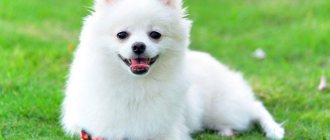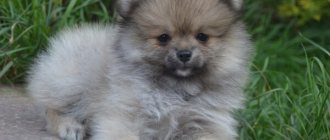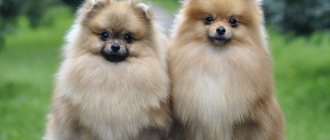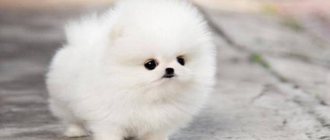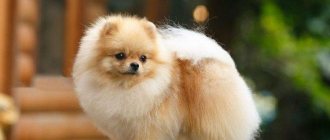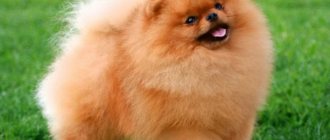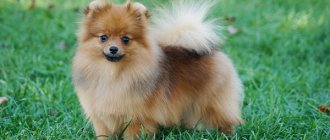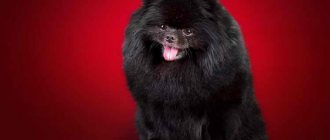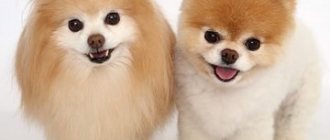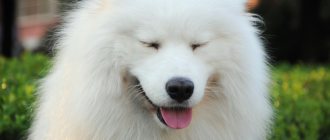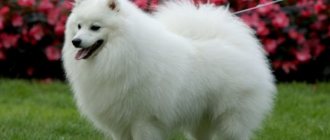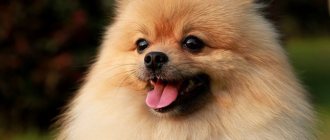Today, the Spitz is very popular among dog lovers because of its exceptionally cute appearance. However, not everyone knows that these decorative dogs come in many varieties of sizes and colors. The history of the breed originated in Germany, and later it spread throughout the world. Breeders from other countries liked the dogs so much that they developed their own version, focusing on their climatic and geographical features.
Pomeranian Spitz
This type of Spitz is divided into several species, since breeders from several countries became interested in its breeding. In America, when creating the breed, the emphasis was on a fluffy undercoat and thick coat; in Germany, they prefer the classic variety, which has straight and long hair.
Based on the type of muzzle, the Pomeranian Spitz is divided into three types:
- bearish;
- fox;
- toy.
At birth, it is impossible to determine the type, since species characteristics appear in about a year. Moreover, all dogs are characterized by thick hair and a ring-shaped tail.
Pomeranian bear type
One of the most sought after representatives of the breed. The Spitz gained great popularity due to its resemblance to small bear cubs. The breed description is as follows:
- The muzzle is flattened, with thick hair on the cheekbones.
- The eyes are black and located close to the nose. Its tip is raised higher than that of a fox spitz.
- Ears are small.
- The coat is very thick, but less long than that of other Spitz dogs.
This Pomeranian will make a wonderful companion, as it gets along easily with people and pets. Its distinctive features are energy, liveliness and friendliness.
Fox type Pomeranian
The breed standard calls for a long, elongated muzzle, which is why this variety is called fox. The height of the animal varies from 18 to 22 cm. Dogs also have fur on their cheeks, round eyes, a narrow chin, and a small nose. A distinctive feature of the fox type is an elongated tail, which other varieties of Spitz do not have. Colors can be different, the most common are red and beige.
The presence of white spots is considered a disqualifying defect.
The fox type is distinguished by being more people-oriented, obedient and playful. Caring for dogs is easy. It is enough to comb the coat twice a week and trim it as it grows.
Pomeranian toy type
This Dwarf Pomeranian is so named because it looks so much like a living toy. This type saw the light of day thanks to Japanese breeders, who took the classic breed with white color as a basis. Later, other shades began to appear. The toy Spitz is very similar to the bear's face in structure. He also has chubby cheeks and wide-set eyes. However, its muzzle is flat rather than rounded. The fur throughout the body is thick and fluffy.
Nutrition
Organizing proper nutrition is based on 3 pillars:
Optimal receipt of all necessary vitamins by the body
As well as minerals, etc. while maintaining a clear balance between them. The following standards are recommended:
Daily requirement for vitamins, fats, carbohydrates, microelements calculated per 1 kg. body:
| № | Name | Puppy | Adult |
| 1 | A | 200ME | 100ME |
| 2 | D | 20ME | 7ME |
| 3 | C | 1mg | 1mg |
| 4 | B2 | 90mg | 40mg |
| 5 | B6 | 50mg | 20mg |
| 6 | B12 | 0.7 mg | 0.7 mg |
| 7 | H | 0.5 mg | 0.5 mg |
| 8 | E | 2mg | 2mg |
| 9 | Calcium | 528mg | 264 mg |
| 10 | Phosphorus | 440mg | 220mg |
| 11 | Iron | 1.31 mg | 1.31 mg |
| 12 | Zinc | 0.11 mg | 0.11 mg |
| 13 | Fats | 2.6g | 1.32g |
| 14 | Carbohydrates | 10g | 10g |
Avoiding chaotic, excessive eating
Owners often want to pamper their handsome dog with something tasty. But “overeating” is dangerous not only due to excess weight, but also problems for internal organs.
Remember, small snacks during the day result in an additional full portion, which will definitely be superfluous.
Determining the type of feed
Natural (homemade) or purchased. Each of which has advantages and disadvantages.
Veterinarians do not recommend giving your dog mixed food - this negatively affects the pet’s health.
Spitz puppies
Homemade food is based on foods with a high protein content. Recommendations for the use of the main products are given below.
Recommendations for introducing basic types of animal and plant products into the diet:
| № | Product | Recommendations |
| 1 | Meat and offal | Ideally, the meat should be raw and frozen. But, in order to avoid the risk of helminth infection, it is recommended to heat treat it. It is enough to boil a little for 2-3 minutes. Due to the high fat content, it is not recommended to include pork in the diet. Give preference to poultry (duck, chicken), rabbit meat, beef. The by-products of these animals (liver, tripe, heart, trachea, etc.) are also recommended. |
| 2 | Fish | Preference is given to inhabitants of the seas (river contains many small bones that are dangerous for pets). Possessing an inexhaustible resource of proteins, microelements, acids, fish does not cause allergies. Improves skin and coat. It is recommended to add fish oil to the main diet of the Spitz, compensating for the deficiency of amino acids. |
| 3 | Egg, dairy products | The egg is not given raw - it must be boiled or fried. Fermented milk products should have minimal fat content. Cheeses are given little by little and not as food, but as a small delicacy - again due to their high calorie content. |
| 4 | Vegetables, grains | Like humans, Spitz needs vitamins contained in fresh vegetables. The little naughty boy will be happy to join you in tasting tomatoes, sweet peppers, zucchini, and carrots. But do not rush to give early vegetables that are not yet in season - greenhouse crops may contain nitrates that have a detrimental effect on health (and not only your pet). In winter, you can treat your pet with dried fruits. Rice is the preferred cereal. |
What not to add to your diet
- purchased semi-finished products;
- spicy foods;
- dishes with high salt content;
- smoked delicacies;
- bones of poultry, fish;
- confectionery, baked goods;
- sausages;
- pickles (zucchini, cucumbers, mushrooms);
- citrus fruits, etc.
Ready-made food is convenient for owners. In particular, there is no need to choose what to give or prepare for your pet, taking into account its need for nutrients and vitamins. Ready-made food already contains the required minimum. In this case, only one question remains to be resolved - which food is suitable for your pet.
Despite its apparent simplicity, the answer to the question should be approached with all responsibility. With a huge selection of offers from various brands, this will not be an easy choice. Here it is necessary to take into account the age of the pet, its state of health, etc., giving preference to special food for small breeds of dogs.
Spitz
Some tips
Tip 1 Advertising is, of course, the engine of progress. But the health of your Spitz is more important to you. Do not believe the beautiful slogans of manufacturers, give preference to premium food. Cheap is rarely quality.
Tip 2 Study the composition carefully. It must be detailed, in Russian. In this case, pay special attention to the amount of protein in the feed. The optimal value is more than 25%, and it should be made from natural products: meat, liver, etc.
Tip 3 The ratio of vitamins and minerals, as well as their concentration, should be suitable for the pet’s breed. Recommended shares are given earlier.
Tip 4 Study reviews about the product, consult with specialist breeders.
Tip 5 Monitor the dog’s body’s reaction to the food. If unusual reactions occur (hair loss, loss of shine, sour eyes, problems with stool, etc.), immediately change the food. Perhaps it is not suitable for your Spitz, causing allergic reactions. Consultation with a veterinarian is recommended.
Tip 6 Strictly follow the instructions and dosage when feeding located on the package. As a rule, the package indicates the daily dosage of the product, not the one-time dosage.
Tip 7 A little trick when feeding dry food (especially at an early age) is to pre-soak it in warm water. Soaked food is more easily absorbed by the baby and is more easily absorbed by the digestive system.
German Spitz
One of the first representatives whose ancestor is the Pile Spitz, considered the oldest European breed. Today there are several varieties of the German breed, differing in size and color. Thus, a Grossspitz (large Spitz) can grow up to 50 cm, and its minimum size is 42 cm.
The smallest German Spitz, the Miniature Spitz, has a height of 18 to 22 cm. Acceptable colors include:
- white;
- black;
- brown;
- zonal gray;
- ginger.
A height of less than 18 cm is considered a defect for Miniature Spitz dogs.
Upbringing
The pets are well trained. Their distinctive features are a sharp mind and unquestioning obedience. Therefore, there will be no problems with education.
The German Spitz dog breed requires a gentle approach. The pets really try to please the owner and do not try to challenge orders or cheat. Therefore, if the dogs do not understand something, it is the trainer’s fault. You cannot be angry with your pets - screams and discontent will frighten them and make them withdrawn.
The general course of Pomeranian training is mastered by six months. Afterwards, they can be taught circus tricks - they dance with pleasure, stand on their hind legs, jump on the owner’s back, and “die.”
No matter how quickly the German Spitz learns the rules of behavior, education cannot be left to chance. No dog is born obedient - it needs to be trained.
Japanese Spitz
The breed first saw the light of day in the late 20s of the 20th century. Their homeland was Japan, where local breeders took the Samoyed Laika as a basis and crossed it with a German Spitz. The dogs are small in size, height ranges from 38-40 cm. The body is dense and strong. The main feature is its snow-white color and thick coat. The nature of the animals is friendly and good-natured. They are well suited for children and can serve as excellent nannies for them. The life expectancy of the Japanese is 10-16 years, which is considered a good age for dogs.
Samoyed
Spitz dogs are often classified as sled dogs because of their external similarity. Perhaps only one dog can be confidently called a Spitz - the Samoyed dog. Large white aboriginal dog of the Russian north. These are extremely strong and hardy dogs , capable of withstanding the most severe frosts.
In city conditions they behave with dignity, but they require quite a lot of physical activity and a long walk . Grooming may seem difficult at first glance, but in fact, shiny white wool has self-cleaning properties. The dog does not need to be washed often; it is enough to brush it once every two weeks, more often only during the molting period. An owner leading a Samoyed dog on a leash attracts the attention of everyone around him. constant smile and friendly disposition always endears him to any passerby.
Spitz dogs are amazingly capable of bringing joy to a person with their appearance and behavior. They sense the mood of their owners very subtly, and are not intrusive; if they are sad, the Spitz will come and quietly lie down next to them, pressing their whole body together. Or he will look into your eyes and put his head on his knees, as if comforting and supporting. But if the owner is cheerful, the Spitz will immediately offer a noisy and fun game.
Spitz are not touchy, they are always ready to fulfill all the demands of the owner. They don’t play dirty tricks at home, don’t chew furniture, you can safely leave them alone, but they get very bored in the absence of family members. Spitz is the most reliable friend , generously giving love and happiness.
Finnish Spitz
In the 19th century, Spitz actively spread throughout the world and came to Finland. There, local breeders develop their own variety of the breed. Finnish Spitz are slightly larger than their relatives, their size is 40-50 cm and their weight is about 10 kg. Such dogs are mobile, active, and can bark loudly, expressing their feelings. They are independent, but at the same time very attached to their owners. The average life expectancy is 12-14 years.
Finnish Spitz can be taken to hunt small animals.
Application
Spitz dogs are mainly bred for fun. Due to their high adaptability to the lifestyle and living conditions of people, pets are suitable for families with children, the elderly and single people.
Their lively, good-natured character has made dogs good psychologists. They are used by psychotherapists in working with withdrawn children and adults with post-traumatic syndrome.
At the same time, dogs are watchmen and security guards. They are always on the alert, warning about the visit of uninvited guests and danger. And if something threatens the owner, they will defend themselves without hesitation.
The qualities of protectors are more pronounced in large varieties of the breed. So, the German Dwarf Spitz is just a toy. He doesn’t even want to go outside again. Another thing is a large German Spitz, Keeshond or Mittelspitz. They will not be afraid of the most formidable and powerful enemy.
American Eskimo Spitz
This breed appeared in America in the 19th century. When it was created, the German variety was taken as a basis. They are excellent companions, have extraordinary intelligence and are easy to train. However, they need to be socialized from early childhood, as Eskimo Spitz dogs can grow up to be distrustful or even aggressive towards strangers. Animals will feel good both as a pet and as a hunter. American Spitz dogs have good health and live about 15 years.
Height
Like all small representatives of “human friends,” the weak point of the Spitz is the joints and bones, which may not withstand its activity, especially if it is overweight. In this regard, one of the main dangers is injury (dislocations, dysplasia, etc.).
Simply observing the pet's movement will help the owner identify the problem. If the baby limps when walking, jumps, gets tired quickly during a walk, or cannot run at all, these are signs of problems with the musculoskeletal system or injuries.
It is possible to reduce the likelihood of such diseases with the help of proper nutrition, strengthening muscles, weight control, and the temporary introduction of additional vitamins and supplements. To prevent the occurrence of such problems, starting from the early stages of life, do not allow your pet to jump from high surfaces or run down stairs on its own.
Wolf Spitz
Another name for the German Wolf Spitz is the Keeshond. He is not just the oldest among his relatives, but one of the oldest breeds on Earth. It is believed that his ancestor was the turf dog, which lived back in the Stone Age. Modern Wolf Spitz dogs appeared in Europe in the 16th century. They are distinguished by a harmoniously built body, their height is about 45 cm, less often - 55 cm. Weight reaches 30 kg. This breed is energetic, sociable and friendly towards children. However, he is wary of strangers. The Wolf Spitz has good watchdog qualities.
The breed is distinguished by its cleanliness. Dogs can wash themselves with their paws, just like cats.
Genetic pathologies
This extremely unpleasant block of diseases includes problems with the thyroid gland, adrenal glands, epilepsy, and umbilical hernia. Another unpleasant “genetic gift” can be black skin disease. It provokes hair loss over large areas of the body with blackening of the skin in these places.
Improper care of your pet becomes, in most cases, almost the main cause of emerging health problems. Untimely vaccinations, treatments against parasites, etc., for everything that the owner did not have time to do or forgot to do - the baby pays.
This thesis can also be applied to proper nutrition. Failure to maintain the optimal balance when forming a diet, introducing non-recommended sweets causes itching, allergies, and indigestion. And excess weight, along with a sedentary lifestyle, negatively affects both the functioning of internal organs and the functioning of joints and muscles.
We must not forget about hygiene. Ears, eyes, and teeth must receive daily preventative care.
Haircut for Spitz
Eurasian Spitz
This variety appeared relatively recently, in the mid-20th century. This is a fairly large animal, reaching 60 cm at the withers. It is distinguished by restraint, calm temperament and endurance. The European is friendly towards his owners and is able to protect his family if necessary. It only uses its voice in case of danger to warn its owners. Thanks to this, the dog will become not only an excellent companion, but also a devoted protector. Life expectancy is somewhat shorter than other varieties of the breed, about 11-13 years.
Behavior
The character of the German Spitz is unique. From the first days of its existence, the breed developed alongside man, helping him farm and brighten up his days. That's why dogs know how to adapt. With calm owners, they lie on the sofa under the steady hum of the TV, with lovers of sports and outdoor activities, they explore the world.
This does not mean that dogs are couch potatoes. They are active, they need to play, walk and be mischievous every day. It’s just that the character of a German Spitz depends on the temperament of the owner. The saying that dogs are like their owners suits this breed like no other. With choleric people they will be hyperactive, with phlegmatic people they will be calm.
All types of German Spitz are sociable and cheerful. They love family. But the attitude towards strangers is different. Decorative breeds are usually friendly, while others are wary of strangers.
Like any dog, Spitz dogs have advantages and disadvantages. They are devoted to their owner and household members, love affection and participate in everyday affairs. But they cannot stay alone for long, even in the next room. You should prepare for the fact that a furball will follow a person around the apartment and poke its nose everywhere. Sometimes it's annoying.
Another disadvantage is excessive loud barking. You can recognize a German Spitz by its abrupt voice, even without seeing the dog. They need to be told everything about even minor events - the arrival of neighbors, a conversation behind a wall, a car passing under the window. They are weaned off this from puppyhood.
Animals are companions that will follow their owner through thick and thin. No matter what a person does, they will be there. After all, the company of people is the best reward for them.
Italian volpino-italiano
This Spitz originates in Florence, Italy. Mention of its ancestors dates back to the 9th century, but dogs were finally formed in the Middle Ages. Volpino is not very tall or heavy: the height at the withers is no more than 30 cm, and the weight is about 5 kg. Usually the color of dogs is white, but sometimes fawn and red are found. They have a restless disposition, which is why animals can react to what is happening by barking. These dogs are extremely active and love to interact with people. Their lifespan is about 13 years.
What do the puppies look like?
During 1 year of life, the appearance of Pomeranian Spitz undergoes significant changes, which every owner of such a dog should be aware of.
Up to 1 month
Puppies are born weighing 55-125 g, they have no hearing or vision, they are absolutely defenseless and very vulnerable. The body of such babies is disproportionate: the head is large and compressed, the body is elongated, the stomach is voluminous, and the legs are short. The body is covered with faint down, through which the skin is visible; its color indicates what shade the dog's coat will be.
Blueness is a sign of the presence of any pathologies.
About 2 weeks after birth, puppies' eyes open, and at 17-21 days, their ear canals open. At the beginning of the 3rd week, babies can empty their bowels on their own, and at the end of 1 month they stand well on their paws and move actively.
Up to 2 months
At 3 weeks after birth, puppies begin teething, causing their gums to become swollen and itchy. Little Pomeranians behave restlessly.
The period from 4 to 8 weeks after birth is associated with laying the foundations of the dog’s behavior and character; at the end of 2 months they are ready to move to a new home.
3 month
The so-called baby or puppy hair begins to be replaced by an adult one. You can already determine the color of the dog.
4-5 month
At this age, puppies do not look very attractive - new hair grows gradually, which is why they seem to be not fully dressed. At the same time, the replacement of milk teeth with molars occurs.
The body of Pomeranians acquires the proportions characteristic of the breed.
6-9 month
Shedding is still ongoing, the change of teeth ends by the 7th month. In some individuals, the molars grow next to the lost milk teeth, which in such a situation must be removed at the veterinary clinic.
At 8 months, Pomeranians can already participate in their first show.
1 year
In bitches, at 9-12 months, puberty begins and the first heat begins. Another molt is taking place. The Pomeranian coat acquires its final appearance by the age of 3 years.
CAREFULLY!
You cannot breed a dog during its first heat. This will negatively affect her health.
Husky and Spitz mix
The breed was named Pomsky. These dogs have become an exclusive designer find, but today they remain not recognized by the International Canine Federation. The color of the Pomsky usually matches the color of the Husky's coat. The most common shades are:
- grey-white;
- black;
- white;
- ginger;
- brown.
Usually puppies have a kind of mask on their face. Dogs are easy to train and are smart. Unlike classic Spitz dogs, Pomskies calmly tolerate loneliness.
Are boys different from girls?
There are no significant differences in the exterior of Pomeranian females and males - both must be compact in size, have a thick coat and generally comply with the official breed standard.
However, it is believed that the judges' preference at the show will be given to male dogs, since they have a more impressive appearance, look larger and have a longer and more voluminous coat.
Pomeranian and Chihuahua mix
This mixed breed, called the Pomchi, is an excellent companion dog. It is small in size, which allows you to keep it in a city apartment and easily pick it up. The dog's weight is only 3.5 kg, and its height is no more than 25 cm. Externally, the Pomchi is similar to a Chihuahua with long hair. The head is round, the ears are large, like those of a Chihuahua, but pointed, like those of a Spitz. Mestizos are loyal, people-oriented.
Diseases
Good pet health is the result of proper care from the owners. To achieve this goal, not only the character and preferences of your pet are taken into account, but also the characteristics of its breed, such as:
- propensity to certain diseases;
- genetic predispositions;
- methods of prevention and treatment.
Despite the fact that Spitz dogs rarely get sick, this does not mean that diseases “pass them by.” Veterinarians name 4 main factors that can cause health problems in a Spitz:
- small sizes;
- structural features;
- genetic abnormalities;
- incorrect content.
But the main danger for the baby is the lack of attention to his charming person. The sociable character cannot stand loneliness. He, and only he, should be at the center of everything that happens. Otherwise - a spoiled mood, blues, which, over time, can develop into serious problems.
Let's consider these reasons and options for minimizing the consequences.
Spitz
Yorkie and Spitz mix
The cross between a Yorkshire terrier and a Spitz received the informal name Cherki. The animal has soft long hair, the colors of which can vary greatly: the color varies from golden to black. It is difficult to predict the height and weight of future offspring; sometimes a born puppy can be twice the size of one of the parents. A dog can easily get into a fight with an enemy that is larger than it, so it needs constant supervision. In general, dogs are very friendly and active, but sometimes they can show the aggressiveness characteristic of mixed breeds.
Anatomical features of the breed
Among the health complications inherent in Spitz dogs, problems with:
- teeth - starting from the period of their replacement. This is caused by rather deep roots. This structural feature leads to the fact that baby teeth, in most cases, do not fall out on their own, preventing the normal growth of permanent teeth. In addition, there is a high risk of gum disease and tartar. Failure to respond to this problem in a timely manner can cause early tooth loss;
- eyes – their increased tearfulness. This is due to the structure of the skull - a sharp transition from the forehead to the muzzle causes the eyes to “bulge.” In addition, this feature leads to vulnerability of the eyeball (inflammatory diseases, dryness, risk of injury, etc.). Therefore, special attention must be paid to caring for your dog’s eyes;
- specific "cough". The larynx of this breed has its own drawback - the cartilages in it are not “closed”. Therefore, against the background of stress or illness, this “cough” may manifest itself. It resembles an animal trying to cough up something that has gotten into its throat. In fact there is nothing there. Just calm your pet, everything will pass.
Spitz
This is interesting: What and how to feed a Scottish kitten per month?
Nicknames for dogs
It is better to choose a short name for the Spitz so that the puppy remembers it quickly. Nicknames for boys:
- Henry;
- Duke;
- Bart;
- Casper.
Popular names for girls:
- Amelia;
- Snowball;
- Bella;
- Thea.
When choosing a nickname, you can focus on the ancient origin of Spitz, personal preferences or the special advantages of the pet.
"Fox" with slanted eyes
The Grossspitz has a wedge-shaped head, tapering to a round black nose. This structure of the skull, as well as the smoothly protruding forehead and slightly rounded cheekbones, resemble the muzzle of a fox. On the dog's head there are erect triangular ears located close to each other. The standard large Spitz has certain proportions. The ratio of muzzle length to head length should be 2:3, and height to body length – 1:1.
The dog's well-developed jaws have a full set of even white teeth - 42 pieces and a scissor bite. A direct bite is also allowed, but the absence of teeth is a big flaw. The Spitz's dark, oval and slightly slanted eyes have an intelligent and cheerful look. When a stranger appears, they acquire a wary expression, and in case of danger, an angry expression.
The compact and harmonious body of the animal is made by a straight back, which ends in a short and wide loin. The German Spitz has a well-developed, voluminous chest and a moderately toned abdomen. The impressive image of the dog is complemented by a tail set high, curled into a ring (sometimes double) and lying on the back. The animal's limbs are well developed physically, which allows it to move freely and accurately forward, springing off the ground.
Where can I buy
The breed is popular in Russia; in many cities there are nurseries that breed Spitz dogs. Among them are:
- Liebe Kinder (Ekaterinburg);
- Fire Fox (Kaluga);
- Mini Gum (Moscow);
- Bon Chanterelle (St. Petersburg).
The price of puppies may vary depending on the class of the pet. On average, a Pomeranian with all documents will cost 25,000 rubles. If you plan to purchase a show-class dog, the cost can rise to 100,000 rubles.
Whatever type of Spitz you like, you should remember that the dog’s behavior is primarily determined by upbringing and training. Therefore, any variety of the breed can become an excellent friend or family companion.
How to choose your future pet?
It is best to purchase a puppy in a specialized nursery from trusted breeders who value their reputation - this will eliminate the possibility of buying a purebred or sick pet.
It is important to inspect the living conditions of the dogs, meet the puppy’s parents, find out about their health and titles if we are talking about buying a breed or show-class pet.
It is also necessary to carefully examine the puppy itself. In a healthy standard dog:
- shiny coat without bald patches and dandruff;
- clean skin without rashes, inflammation and scratch marks;
- there is no increased lacrimation, discharge from the nose and eyes;
- ears are clean, without unpleasant odor;
- pink mucous membranes;
- not bloated belly;
- scissor or straight bite.
The puppy must be active, cheerful and inquisitive; aggression is unacceptable.
Reference! The size of the puppy should not determine the choice - even the smallest pet can grow up to be a large dog.
You should also decide in advance about the gender of the dog - its character largely depends on this. So, males are more stubborn and independent, while females are more obedient, more affectionate, and easier to train. In addition, if there are plans for the pet to participate in breeding the breed, then the choice should be a girl.
Interesting Facts
Interesting Facts:
- one of the legends says that dogs of this breed accompanied the wise men who came to worship the newborn Christ;
- dogs are so clean that they can wash themselves like cats;
- Spitz rose very quickly “from rags to riches” - in about 100 years;
- I. Newton had a pet Pomeranian Spitz. Legend has it that one day a playful dog knocked over a candle on valuable manuscripts and they were destroyed. But he was loved and therefore forgiven by the owner;
- of the 20 animals that set sail on the Titanic, only 3 survived. And two of them were Spitz dogs;
- Loud barking from dogs is not harmful. The need to loudly warn of danger is genetic. After all, it was with this activity that the history of the breed began.
Which owner is most suitable for this dog?
Grossspitz are unusually cute, which is why many people want to have such a pet. However, not everything is so simple - the breed may not be suitable for everyone.
So what should you consider?
- The Grossspitz is unlikely to suit homebodies and lazy people. Of course, the dog will not bother the owner, given its sensitivity. She perfectly captures people's moods. However, due to its nature, it still needs frequent and, preferably, long promenades. And even with loads! Not all people dream of spending time like this every day, I’m sure. Therefore, you should immediately decide for yourself whether there is enough energy for such a pet?
- People who often go on business trips, vacations and for any other reason are not at home most of the time should also not get a Spitz. This dog does not tolerate loneliness very well. That is, of course, she can be alone at home. It’s especially great if a person also has pets to play with. However, long separations from the owner depress this dog. Therefore, it is important to be at home often. Or at least have a Pomeranian in a large family when someone is always there.
- If a person suddenly lives outside the city and has livestock, Grossspitz are unusually good as shepherds. By the way, they can still often be found in a similar role in Holland and Germany. Therefore, I strongly recommend getting yourself such a shaggy assistant.
- If a person suffers from loneliness or is subject to frequent bursts of sadness, the Grossspitz is an excellent remedy for such ugliness! Some psychotherapists even use such animals in special therapy, which is designed to help people with certain problems.
- If you want to have a pet that would accustom your child to the wonderful world around him, large Spitz dogs are great helpers! As I already wrote, they love children. And so much so that they act as a nanny. It is also very convenient that the Grossspitz is far from the smallest dog. That is, a child is unlikely to accidentally harm him.
Owner reviews
On the Internet you can find both positive and negative reviews from Spitz owners. If you look at it, the negative experience of ownership is based on the unpreparedness of the future owner to raise and communicate with a temperamental dog.
Irina S. I didn’t even know there were so many Spitz dogs! I thought it was a Pomeranian plush miracle, German and that’s it. But it turned out there was a whole group of them. I learned this when we were looking for a hunting dog for my husband. We bought a Finnish one. What a redhead he is - it even blinds your eyes when he runs through the white snow. But the character is complex. She loves her husband immensely. The rest, it seems to me, he simply respects as members of his family. We live in a private house, the dog walks and exercises a lot. This is a must.
Maxim O. Gave his wife a Pomeranian. I thought that “bear cub” was an affectionate nickname. And this is the type of dog. It seemed like I had come to a toy store - the puppies seemed unreal. I thought the dog would only be for his wife, but he became attached to the little one. Very smart, protective.
Oleg R. I have a Wolfspitz. Really looks like a wolf and has the same stern disposition. The first dog of this type, so he made a lot of mistakes. Since childhood, I treated him like a funny fluffy bear and allowed me a lot. I grew up and problems began. He is not evil, but stubborn. If he doesn't want to, he won't do it. We went to dog trainers and corrected all the flaws in our upbringing. What can I say - any dog needs training. This is a living creature, it wants to walk, eat tasty food and communicate with people.
What types of Spitz are there and how do they differ?
Spitz dogs can be divided into groups according to a variety of criteria. For example, hunting, draft, decorative and security. But the greatest interest for future owners is the division of dogs of this breed by size. If you are choosing a dog to live in an apartment, you should hardly pay attention to large individuals with a developed sense of security and territory. Such a dog will simply get bored at home and quickly become depressed.
We propose to divide Spitz into varieties:
- dwarf or miniature - their height at the withers does not exceed 20 cm;
- small - from 20 to 29 cm;
- medium - from 30 to 39 cm;
- large - from 40 to 50 cm;
- large - from 42 to 55 cm.
Despite the common standard features, all Spitz dogs have their own character traits, pros and cons of keeping them. Let's talk about them in more detail.
Tiny
From the name it becomes clear that such a dog will look more like a toy. Mini-Spitz grow no more than 22 cm at the withers. These are small teddy bears that will become excellent companions and will be ready to accompany their owner everywhere. These dogs cannot stand loneliness; they need constant contact with a person.
Pomeranian (dwarf) Spitz
The weight of the orange does not exceed 3-4 kg. Despite the decorative nature of such a dog, it needs active games. This is not a couch dog who will sleep all the time. The Pomeranian has inherited the character of his ancestors and during a walk he will boldly bully not only animals of equal size, but also larger individuals.
Babies come in cream, white, and red. There are two types:
- bearish;
- fox
Dogs get along well with other pets, but require a lot of attention. If it is not enough, they may become jealous and express dissatisfaction with hooligan antics. They love to bark loudly, notifying the owner of all interesting changes in the environment.
Cost - from 45 to 150 thousand rubles. Depends on the rarity of the animal’s color and exhibition prospects.
Small
The group includes representatives of the breed that do not grow more than 30 cm at the withers. Another name for such dogs is Kleinspitz. By the way, this group also includes standard Pomeranians, whose height reaches 28 cm. The weight of small representatives of the Spitz varies between 8-10 kg. But for an orange, this figure should not exceed 6 kg.
The life expectancy of small Spitz dogs is quite long - from 15 to 18 years. This is explained by good health and the absence of a large list of breed diseases. The quality of life of such a pet depends on the owner’s ability to provide him with active walks and constant intellectual activity. Dogs learn quickly and love the process of learning new commands.
However, Kleinspitz dogs have a unique character and may not get along with every family member. But others treat their four-legged pets calmly and friendly.
German Spitz
One of the most popular breeds in the group (weight no more than 10 kg). The life expectancy of a German is from 13 to 17 years. The standard provides color options:
- cream;
- grey;
- brown;
- carbonic;
- bright white.
Externally, dogs resemble a square. The tail is perkyly wrapped in a donut. The areas on the neck, chest and tail have longer hair.
His small size does not prevent the German from being an excellent defender and danger signaler. These dogs love a family that includes other animals. They are friendly and tireless in games and fun. Well trained, but require a firm hand. Otherwise, they may grow up stubborn and disobedient.
Cost: from 25 to 80 thousand rubles.
Volpino Italiano
Volpino (translated from Italian as “fox”) belongs to the group of small Spitz dogs, since its weight does not exceed 5 kg and its height is 30 cm. Another name for the breed is Florentine or Palace. Initially, Volpino could be seen on the streets of Florence, when they accompanied trade convoys with their ringing bark. Then the snow-white dogs moved and firmly settled in the palace chambers of the nobility.
Acceptable Volpino colors:
- bright white;
- beige;
- ginger.
The bark of this dog is in no way comparable to its miniature size. It is so loud and strong that a better guard against uninvited guests could hardly be found.
The cost of dogs of this breed reaches 90,000 rubles.
American
The American line of Eskimo Spitz has several branches that differ in size:
- toy - from 23 to 29 cm at the withers;
- mini - no more than 38 cm;
- standard - grows up to 48 cm.
The rarest and most expensive representative of the breed is considered to be of the “toy” type. Its weight does not exceed 4 kg. Eskimo representatives of the dog group do not have an approved standard; their description is based on criteria common to all Spitz dogs. It is believed that individuals of the Samoyed Laika were used in the breeding work. The smallest representatives of the American branch are used as companions. Larger animals successfully serve as guards and shepherds among the indigenous population of Alaska.
The breed is not recognized internationally, only by the US National Federation. The dog will be an excellent option for a family who wants to have their first pet. He will not only be an excellent playmate for children, but also an excellent guard. Eskies (as the dog is called in its homeland) have a very developed sense of territory and distrust of strangers.
Cost - about 60,000 rubles. It is worth understanding that the dog will not have documents that are recognized by the FCI.
Average
This category includes dogs whose weight can reach 17-20 kg and height 38-40 cm. The future owner should think twice before getting a fairly large Spitz. If you do not plan long walks with active games, such a dog is unlikely to suit you. A dog of this breed, constantly sitting at home alone, will demonstrate behavior that is similar in destructive power to a hurricane. This does not mean that the breed is characterized by bad behavior, it is just a natural reaction to boredom and accumulated energy.
Mittelspitz
The “medium” Spitz has a fairly compact size - height up to 36 cm, and weight up to 15 kg. The definition of average refers only to the size of the dog of this breed, its mental abilities are at the highest level. Dogs are playful and loyal. Among the representatives of the breed you will not find an aggressive or embittered dog. But gaps in training can turn a dog into a stubborn and unyielding dog.
They love children and get along well with other pets. It's better if they grow up together.
The average price is 40,000 rubles.
Japanese
Interestingly, this breed is recognized by all cynological federations of the world. The exception is American. The USA considered that Japanese dogs were very similar to mini-line Eskimo Spitz dogs, so they refused official recognition. The Japanese have snow-white fur, pointed ears and a pointed muzzle.
The homeland of the Japanese variety is Tokyo. Breeders bred the breed using individuals of exclusively snow-white shades.
A feature of the breed is considered to be pathological sensitivity. This does not mean that the dog will show aggression in response to an insult. But he is able to show the owner that he is very upset by his behavior and will punish him with a long period of “silence”. This dog is suitable for families with children who need an additional protector of the territory. The dog will not let strangers through, will not show aggression in response to children's pranks, but will simply walk away.
The average price is from 30 to 70 thousand rubles.
Large
The future owner of a Spitz should understand that the larger the representative of the breed, the more difficult it will be with him. Such dogs are suitable for living in a private home; their thick coat allows them to live in a spacious, insulated enclosure. Among the representatives of large Spitz dogs you can find dogs that will become excellent guards or share with a person his passion for hunting.
Grossspitz
A powerful dog with a height at the withers of about 45 cm, developed intelligence, and a sense of territory. A distinctive character trait is a pathological reluctance to obey. The breed was bred by French, German and English farmers as an assistant in grazing livestock. This is what explains the animal’s autonomy and independence. It is capable of making decisions on its own.
Standard colors of Grossies:
- black;
- white;
- brown.
Properly raised from childhood, the Grossspitz is distinguished by an easy-going character, respect for even the smallest family members and playfulness. If you are not ready to work with the puppy from the very first days, walking the dog for at least 40 minutes three times a day, this breed is not for you. Grosses feel very bad in the cramped conditions of a small apartment.
Average price of a puppy: from 25 to 60 thousand rubles.
Finnish
The breed has a complicated history. The reason is that selection was carried out simultaneously in two countries (Finland and Russia). The result was the emergence of two lines of dogs in one breed group. They differ slightly in appearance and character.
The Finnish Spitz is a classic hunting dog. With it, the future owner will be able to hunt bears, fur-bearing animals, upland game and rodents. Dense coat with a thick undercoat allows Finnish dogs to live in outdoor conditions. A private house is suitable for her, but not an apartment. In an urban environment, a dog will quickly get bored. She needs frequent walks, and not rare trips “every once in a while.”
The peculiarity of dogs of this breed is:
- fiery red fur (or red), most similar to a fox;
- arrogant character, which is expressed in ignoring the owner’s commands and frequent escapes.
Cost: within 50,000 rubles.
Large
These are dogs that often outgrow 50 cm at the withers, and their weight can reach 45 kg. It is worth understanding that only an experienced owner can handle such an animal. You should not get a large Spitz as your first pet and trust children under 14 years of age to walk it.
Wolfspitz (Keeshond)
Wolf Spitz owe their appearance to the Netherlands. At a certain period of time, dogs had a different name - “barge dogs”. It appeared because of the designation of the type of activity for which wolves were used - protecting barges from hordes of rats and mice. One of the largest Spitz dogs - weight up to 30 kg, height up to 50 cm.
The dog received its modern name because of its unusual color - black and gray hairs alternate in the general mass, and light “glasses” clearly stand out on the eyes. Dogs are very attached to all family members, especially children. They are able to tolerate not very neat games of younger family members.
They need long walks, active exercises, and constant games. Thick, fluffy coat requires careful grooming - combing.
Average price: 50,000 rubles.
Karelian bear husky
A large dog, reaching 57 cm at the withers. This is the only smooth-haired representative of the breed group. The main color of huskies is black. There are often white spots and tan marks. They are classic hunters, ideal for hunting large game. A character trait is the adoration of a single owner. Only with him the dog will go hunting and work effectively. Distrust of strangers does not allow the dog to go hunting with other people.
Before getting such a dog, you need to understand for what purpose the pet is being purchased and whether it will have to be housed later if it is not physically busy enough and gets bored at home.
Average cost: 60,000 rubles.
Eurasian
The Eurasier is both a Chow Chow and a Wolfspitz. This should not be surprising - after all, these are the breeds that participated in the selection. The height of males at the withers can reach 60 cm, for females the standard is lower - up to 56 cm. The color of the Eurasier can be any, with the exception of white. It’s interesting, but you can’t tell a puppy exactly what color his coat will be when he grows up. After shedding and the puppy fluff falls out, the shade will change. It will either be darker or lighter.
Despite their enormous size (males can weigh up to 55 kg), the dogs are distinguished by their flexible disposition, obedience and adore their owner. They are loyal to children and small pets. Even if you live in a private house, you should not place your dog in an enclosure. Such a life is not for him, he will consider himself abandoned and will quickly fall into depression. He needs constant visual contact with a person.
The average cost of a puppy is from 80 to 150 thousand rubles.
